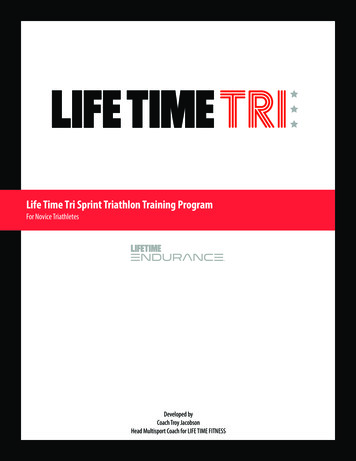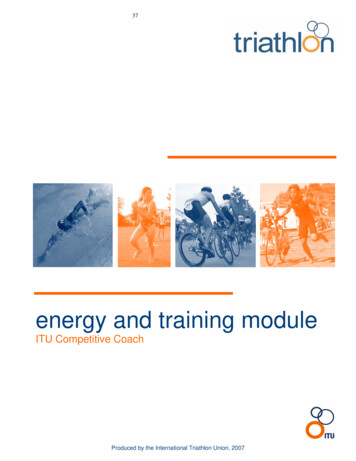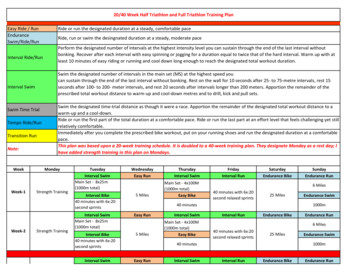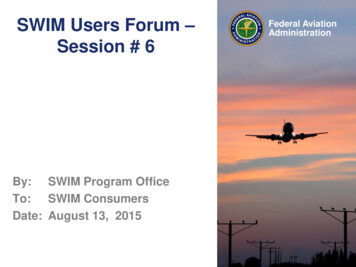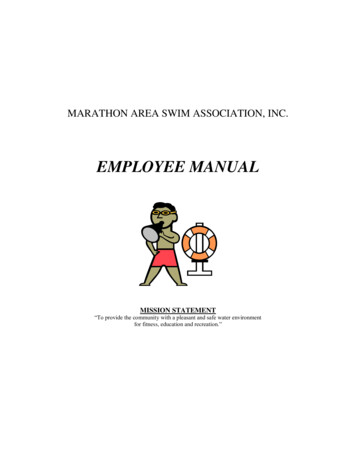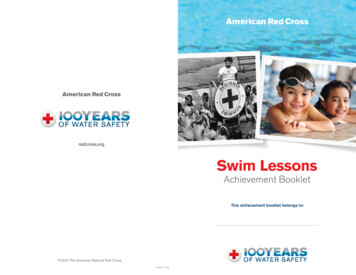
Transcription
Building a Masters Swim ProgramA Guide for SuccessSteps for setting up your Masters swim programUpdates December 2017
Building a Masters Swim Program – A Guide for SuccessTable of ContentsIntroduction to U.S. Masters Swimming . 3Introduction . 3Masters swim clubs . 3National office . 3The Purpose of U.S. Masters Swimming. 4Mission statement . 4Vision Statement . 4Goals and Objectives . 4Core Objectives. 4Benefits of an Adult Aquatic Fitness Program . 5USMS Membership Benefits . 6Fitness / participation programs . 6Exclusive information and content. 6Competition programs . 6Recognition and awards . 7Insurance . 7Volunteerism . 7Grants . 7Partner discounts . 7Starting an Aquatics Swim Program . 8Common traits of successful clubs . 8Determine interest and identify target audience . 8Facility usage . 8Determine practice times . 9Club membership dues . 9Establish credibility. 10Develop good relationships . 10Provide recognition . 10Program activities. 10Local swim, bike, or run shop support . 11Advertising . 11Masters Club Registration . 121
Building a Masters Swim Program – A Guide for SuccessClub Operations and Administration. 12Getting started. 13The Club as a Business . 15Basic accounting . 15Tax-Exempt Status for Non-Profit Organizations . 17Federal recognition . 17State recognition . 18Safety and Risk Management . 20Insurance . 20Meeting the Needs of All Swimmers. 22Every type of swimmer is important . 22Fitness activities . 23Benefits and recognition . 24Publicity and Marketing Ideas . 26Newsletter and club website . 26Sharing club activities . 26Social media . 27“Find a Place to Swim” on the USMS website . 27Publicity materials . 27Stroke clinics . 27Meetings . 28As the club grows . 28Where Do I Belong? . 29LMSC Boundaries . 29Where to Find Help . 342
Building a Masters Swim Program – A Guide for SuccessIntroduction to U.S. Masters SwimmingIntroductionOver 60,000 men and women nationwide, ages 18 to over 100, plus many morein countries around the world, participate in Masters swimming. Mastersswimming is an adult aquatic fitness program for individuals who have chosenaquatics as their means of exercise for a healthier lifestyle. U.S. MastersSwimming (USMS) programs do not discriminate between levels of ability or theindividual goals of its members. There are many different types of swimmers.Some are highly competitive; others swim for fun or fitness. Many prefer openwater events or triathlons.Masters swim clubsSwim clubs are groups of Masters swimmers organized for the purpose oftraining, fitness, and enjoyment of swimming. Members may work out in one ormore pool facilities, usually under the direction of a coach. Clubs offercamaraderie and social opportunities to swimmers.National officeU.S. Masters Swimming (USMS) is the national governing body for all adultswimming programs in the United States. The purpose of this publication is togive prospective coaches and clubs an idea of how to get started, to give newclubs ideas to help them grow and be successful, and to aid established clubs infinding information and ideas that will result in a fresh and creative approach torunning their organizations.We hope this booklet will serve you well, and we look forward to your continuedparticipation in the U.S. Masters Swimming.3
Building a Masters Swim Program – A Guide for SuccessThe Purpose of U.S. Masters SwimmingMission statement To promote health, wellness, fitness, and competition for adults throughswimmingVision Statement USMS will be the premier resource for adult aquatic fitness in the UnitedStates and will make fitness through swimming available for as many adultsas possible.Goals and Objectives To encourage and promote improved physical fitness and health in adults. To offer adults the opportunity to participate in a lifelong fitness and/orcompetitive swimming program. To encourage organizations and communities to establish and sponsorMasters Swimming programs To enhance fellowship and camaraderie among Masters swimmers. To stimulate research in the sociology, psychology, and physiology ofMasters swimming.Core Objectives Service the membership. Educate the membership. Build the membership.4
Building a Masters Swim Program – A Guide for SuccessBenefits of an Adult Aquatic Fitness ProgramThe benefits of providing an adult aquatic program in regard to a facility are as varied asthe swimmers that participate in the program itself. Pools are a big draw to membership.Studies have shown that even if a prospective member does not plan on using the poolfor lap swimming, they would be more likely to join a gym that has a pool versus nothaving one. Very much like a hotel. Do guests ever go swimming or even use a hotelpool? Rarely. But almost every hotel has a pool, because for a guest, it sets a standardfor the services that the hotel may provide.It is prudent that facilities now find ways to pay for the cost of maintaining the very thingthat brought the membership in. To simply leave the pool empty costs money. Swimlessons, summer swim team, water aerobics, and open lap swimming tend to use thepool more heavily in the warmer months. An organized, coach led swim programprovides year-round use of the pool.Members of swim programs have numerous reasons for joining,including: On deck coaching Structured workout regimen Motivation Camaraderie and fun Stroke technique evaluation Learn the latest swimming skills Family social activities Access to poolsQuestionnaire answers of personal benefits gained from swimming: Makes me happy Feel healthier Will allow me to live longer Improves my personal relationships Gives me more energy Perform better at work Able to channel my competitiveness constructively Gives me confidence socially Helped me overcome personal fears5
Building a Masters Swim Program – A Guide for SuccessUSMS Membership BenefitsBecoming a member of USMS and joining the group of 65,000 members around thecountry has it rewards and benefits. Along with the comradery and social aspects of aMasters program come many wonderful things from USMS that only members receive.Fitness / participation programs Opportunity to participate in the SmartyPants Vitamins USMS Fitness Series –three annual events designed for swimmers who want to focus on achievement,improving fitness levels, participation, and fun Opportunity to participate in Try Masters Swimming Week, an initiative tointroduce the many benefits of swimming and U.S. Masters Swimmingmembership to people who want to learn to swim, swim for fitness, or compete inswimming Opportunity to participate or compete in the USMS 1-Hour ePostal Nationals,USMS 3000/6000-Yard ePostal Nationals and the USMS 5K/10K ePostalNatioals. You conduct the 1-Hour Swim and any or all of the distance swims inyour local pool then submit your results for tracking and recognition Opportunity to participate in popular fitness programs such as USMS Go theDistance Opportunity to attend USMS stroke development clinics Opportunity to be included in monthly promotions, initiatives, and contestsExclusive information and content Subscription to the bi-monthly member publication SWIMMER magazine Subscription to the monthly member e-newsletter Streamlines Opportunity to receive the monthly coaches e-newsletter Streamlines forCoaches Exclusive access to Online workouts, written by USMS-certified coaches, inseven different categories Opportunity to create your own blog on the usms.org website Fitness tracking of multiple activities in your personalized Fitness Log (FLOG)Competition programs Opportunity to compete in any of USMS more than 600-sanctioned regional andlocal pool and open water events Opportunity to compete in Nationwide USMS Spring Nationals and USMSSummer Nationals Opportunity to compete in USMS Open Water Nationals6
Building a Masters Swim Program – A Guide for Success Opportunity to attend USMS weekend programs such as the High PerformanceClinic Coaching Exclusive access to Online workouts, written by USMS-certified coaches, inseven different categories Access to coached workout programs in your area Access to more than 1,000 Masters clubs and workout groups that providecoached workouts all across the country, for when you are traveling Opportunity to receive support including visits from USMS Club and CoachServices in developing your programRecognition and awards Tracking and archiving your event results on USMS.org Recognition and awards if you achieve Top 10 or All American status Record personal training achievements Masters Coach Certification (Levels 1-2-3-4) Adult Learn-to-Swim instructor certificationInsurance Coverage while participating in USMS insured activities, including 25,000 ofexcess accident insurance for medical and dental, 5,000 of accidental deathinsurance, up to 650 of temporary disability insurance, and liability insurance forUSMS practices, meets, and approved activitiesVolunteerism Opportunity to serve in a leadership position within your Local Masters SwimCommittee (LMSC) and U.S. Masters Swimming committees USMS Awards recognize the extraordinary efforts of our volunteers. USMS isgrateful to the hundreds of volunteers who give their time.Grants The USMS Swimming Saves Lives Foundation provides grants and resources foradult learn-to-swim programs. If swim lessons for adults are part of your club’sprogramming, you might be eligible for support.Partner discounts Exclusive partner discounts7
Building a Masters Swim Program – A Guide for SuccessStarting an Aquatics Swim ProgramThe following is a checklist for starting a quality swim program. There are a number ofimportant things to consider and decide upon prior to starting a program. From finding alocation (pool) to recruiting program members, to collecting dues, a successful Mastersprogram requires planning and organization.Common traits of successful clubs Stable pool situation Coaching leadership Supportive volunteer group Maintain a standard of excellence Program available to everyone A well thought out financial baseDetermine interest and identify target audience Anyone 18 years and older Parents of age-group swimmers are often former swimmers Local triathletes Post-college swimmers, former high school and age group swimmers in the area Fitness and/or lap swimmersFacility usageFinding a pool location for your program is one of the first things you need to do.Researching your area for pools and then working with the facility to get a Mastersprogram started requires planning. You want to be able to find a pool that has time toallow for your program practice times as well as be supportive and excited about havingthe program. A Masters program can bring a lot to a facility in terms of revenue,volunteerism, and facility awareness. Private sports clubs Public facilities Colleges and universities YMCA and JCC Retirement communities Military bases School district pools8
Building a Masters Swim Program – A Guide for SuccessDetermine practice timesHaving a variety of practice times for you program can greatly influence the number ofmembers who participate and their overall happiness. Only having one practice time aday is limiting and if that time is not doable by a majority of your swimmers, yourprogram will quickly dwindle in size. Negotiating for lane space at your facility can bedifficult, but in the end very worth the effort. Here are some practice times that work wellfor Masters swimmers.5:30 a.m. to 7:00 a.m. Ideal for most working adults Be flexible as many may need to jump out of practice early7:00 a.m. to 8:30 a.m. Can be good for working adults depending on their work schedule An alternative for those who don’t want to get up for the 5:30 a.m. practice8:30 a.m. to 10:00 a.m. Preferred by Moms after getting kids to school and husband off to work Preferred by those swimmers who are retired or work from home Best for those who work from home or have flex work hours11:30 a.m. to 1:00 p.m. Used when pool located near workplace Keep to hour in length –swimmers have a limited amount of time A favorite of triathletes6:00 p.m. to 7:30 p.m. Works for singles or those who have no young kids After work so swimmers have time to get to practice Another popular workout time for triathletes7:00 p.m. to 8:30 p.m. Allows dinner with family Few commute issues Provides daylight hours for run and/or bike workouts prior to swim practiceClub membership dues Base fees on pool rentals, lifeguard fees, salaries for coaches, other expenses When determining fees, barter services for pool rentals and lifeguards U.S. Masters Swimming and LMSC club registration fees9
Building a Masters Swim Program – A Guide for Success Printing and mailing a regular newsletter Club services (administrative costs, billing, office costs, etc.) Website fees Activities (social functions and their costs) Club marketing and promotional expensesEstablish credibility Create a name for the club Tailor workouts for all Masters swimmers, including competitive, fitness andtriathletes Be on time for practice and look professional Take an interest with each swimmer, determine their goals Develop a newsletter, website, and Facebook page Establish a brand (image, logo, and mission statement)Develop good relationships Give members ownership in the program by delegating Have team parties and social events Include spouses in group activities Send out a newsletter and create a website and Facebook page Fundraising and sponsorshipsProvide recognition Create a newsletter (see Constantcontact.com) Create a team website ( see Club Assistant or Team Unify) Create a team Facebook page Use Twitter Have a bulletin board in pool areas Seek out local newspaper support and recognition Be on deck in front of peers Have and attend team eventsProgram activities Select meets in the area your program supports with participants and/orvolunteers Team stroke clinics10
Building a Masters Swim Program – A Guide for Success Community service projects Support other swimming activities (high school or local college championships)Local swim, bike, or run shop support Partnership provides a win-win for both parties and increases member benefits 10% discount for your team members (exchange for supporting their store) Include them in all your activities and brochures, newsletters, etc.Advertising Word of mouth Flyers, brochures, posters posted at workout facility (see Vistaprint.com) Club and USMS website Attend triathlons and distribute brochures Attend triathlon, bike, and run club meetings in your area and distributebrochures Provide T-shirts and caps with your logo Provide a polo shirt with your logo for your coaches Seek out local newspaper support and recognition11
Building a Masters Swim Program – A Guide for SuccessMasters Club RegistrationThere are over 1,000 Masters swim clubs and workout groups registered with U.S.Masters Swimming through 52 Local Masters Swimming Committees (LMSCs). Theannual cost of club membership includes an LMSC fee (varies from one LMSC toanother), plus the U.S. Masters Swimming registration fee. You can register formembership online at usms.org by clicking on the “Join USMS” button and following thesimple instructions. Applications for membership can also be obtained from your LMSCRegistrar.As part of the club application process, new clubs must choose a name and a four-letterabbreviation. Clubs re-register each year between October 1st and November 1st. Youcan register a club online or by filling out the Club Membership Application.A club must be registered before individual swimmers may register with that club.Individuals will renew membership between November 1st and December 31st, so it isimportant to have every club registered or renew its membership before this time.Individual membership application forms are available online at usms.org or from yourLMSC Registrar. The cost of membership, in effect through the calendar year, includesa national fee plus an LMSC fee (which varies from one LMSC to another). Onlyregistered U.S. Masters Swimming members may participate in USMS sanctionedevents and only members of the same club may officially swim together on relays atUSMS sanctioned events.Swimmers register with a Masters club, depending on clubprocedures, by one of the following ways:» Registering online usms.org and clicking on the “Join USMS” button.» Completing an application for U.S. Masters Swimming membership and sendingit to the club Registrar with the annual fee and club dues, or» Sending a completed U.S. Masters Swimming application (stating clubmembership) directly to the LMSC Registrar and separately signing up with aclub.U.S. Masters Swimming membership is annual. New members may sign up as early asAugust 1 for a 17-month membership with your membership active through the followingDecember 31. You may renew your membership as early as November 1 withmembership active through the December 31 of the following year.Club Operations and AdministrationHaving a club does require leadership roles as well as other positions to make itsuccessful. Determining a plan of how you want your club to operate and what’s neededto make it run successfully is important.12
Building a Masters Swim Program – A Guide for SuccessClub representativesThe U.S. Masters Swimming Club Membership Application requests names andaddresses of the following club officers: Contact Person Club Delegate to the LMSCOther positions important to club managementOther positions can be important within your club. Depending on your structure and clubsize, you may want to adopt the following positions: President Secretary Treasurer Newsletter Editor / WebmasterRemaining dutiesHere are some other important responsibilities depending on club size, ambitions, andgoals: Activities/Social Director Publicity Chair Records Keeper Relay Coordinator Coaching Coordinator Travel Captain Promotions/Marketing Chair Awards Chair LMSC Representative to serve on the LMSC boardGetting startedThe first work of a new club can include: Creating by-laws – Each state has unique laws. Please consult a professional oruse a legal service such as legalzoom Outlining offices and committee responsibilities Electing officers and appointing committee chairs Naming the club or team Creating a budget Agreeing on a charge for dues13
Building a Masters Swim Program – A Guide for Success Hiring a coach Securing a pool Determining practice times Opening a checking account Registering with USMS Developing a program registration format (individual program registration can bearranged on your own or with a third-party vendor such as Club Assistant orTeam Unify) Deciding on methods of communication with members: E-newsletter, bulletinboard, telephone tree, announcements at practice. If through the e-newsletter,how frequently? Discussing whether to apply for tax-exempt status14
Building a Masters Swim Program – A Guide for SuccessThe Club as a BusinessThinking of and operating your club as a business is important for a successful club.Following good business practices can keep order and accountability within the clubstructure and its operations.Basic accountingThe checking accountAvoid fees, on line access limit to data inquiry, minimum two authorized signors;Treasurer, Finance Chair, recommend PresidentPaying billsManual checks: Carbonless 2-part checks; Computer checks: 1 check per page, bottomhalf tear off check copy. Pay only on documentation, use spending authority limitReimbursing members, use expense form AND require documents, verify authorizationto spendFiling, record keeping, retention Staple check copy to documents or write check number on top of stapleddocuments. File check number order. Audit trail, ability to trace summary data on FS to each and every singletransaction and for disbursements must clearly indicate who approved. Required to keep 3 years after due date of tax return or 2 years after filing taxreturn, whichever is longer; prefer 7 years. Bank reconciliation – do monthlyDeposits Restrictively endorse checks “For Deposit Only” upon receipt from members ormail. Carbonless 2 part deposit slips, list every deposit item, and copy every check. Retain bank deposit verification. Staple deposit slip copy, bank verification and check copies together. File bydate. Consider accepting credit cards for payment and monthly dues Itemize accounting break out for every deposit. Use manual or electronicspreadsheet. Determine who is responsible for deposits, Club Registrar or Treasurer?15
Building a Masters Swim Program – A Guide for SuccessBad checksDecide: who is collection enforcer; do you charge for returned checks (does your bankcharge fees for returned checks), NSF (Not Sufficient Funds) checks can be redeposited once. Some banks do this automatically. Returned checks with holespunched in the account number cannot be re-deposited.Call 1st: call check maker.Collection secret, you can call the bank upon which the check is drawn against, ask foraccounting, give them the account number, check number and amount of check andinquire whether there are sufficient funds to cover the check. Just because there arefunds when you call does not mean they will be there when you re-deposit the check.Segregation of dutiesChecks and balances. One person should not be in control of multiple transactions,reporting and review functions. If one person has to be in control of multipletransactions, then there must be oversight and control functions that mitigate theprocedures.Individual receiving checks in mail should not be check signor.Bank reconciliationMUST be performed by someone who does not sign checks or prepare deposits. Note:if secondary check signor does not typically have access to checks and does nottypically sign checks, that person can perform the bank reconciliationFinancial statementShould be performed by someone other than primary check signor.Periodic reviewAn independent person should perform disbursements and deposits and relateddocuments.Chart of accounts (COA)What is it? A listing of all accounts.How to use it? For management purposes as distinguished from tax accountingclassifications.Major categories: Assets Revenues Liabilities Expenses EquityAccounting tipsPurchase Quick Books software or a new laser jet printer. Just expense those items asoffice or office equipment line item. Great accounting program for the non- accountant.16
Building a Masters Swim Program – A Guide for SuccessDo not go crazy and set up a line item for every transaction type. Consider whetherthere is a management need to track expense.ReportingAnnual Financial Report to club membership, complete Income Statement and BalanceSheet.Budget, not required but highly recommended.Interim communication to members is simply good business practice. Web site and/ornewsletters. Same for annual financial report and budget.BudgetingBottom up – from each budget center head. Top down - dictated by management.Zero based, every line item starts at 0 and builds up from there.Historical results a good basis for developing budget items and estimating budgetneeds. However, do not exclusively rely upon history.Spreadsheets, highly recommended. Use someone handy in spreadsheets. Useful toevaluate when historical data compared to budgets and proposed budget.Tax-Exempt Status for Non-Profit OrganizationsFederal recognitionApplication for recognition of exemption from federal tax can be made under section501(c) of the Internal Revenue code. Taxes will not have to be paid on membershipdues, but this will not exempt any income that is not related to your tax-exempt purpose.It is recommended that a CPA, tax consultant, or lawyer who has specific knowledge oftax-exempt nonprofit organizations, be consulted to determine under which subsectionyour group should file: 501(c)(3) Educational, religious, etc. - includes Amateur Sports. 501(c)(4) Civic Leagues, Social Welfare Organizations - Promotion of communitywelfare; charitable, educational or recreational. 501(c)(7) Social and Recreation Clubs.There are some distinct advantages to each category. The following are pros and cons,found through experience, by some Masters organizations. For specifics, contact a taxspecialist as described above. The 501(c)(3) classification is the only one in which a gift is tax deductible to thedonor. Children’s organizations, and those devoted entirely to competitive sports,have the best chance of attaining this classification. The 501(c)(4) classification requires the organization to show that their programwill benefit the community in some way, such as health benefits throughswimming. Income generated by your tax-exempt purpose, i.e., to promoteswimming for physical fitness and competition, is not taxed.17
Building a Masters Swim Program – A Guide for Succ
Building a Masters Swim Program - A Guide for Success 3 Introduction to U.S. Masters Swimming Introduction Over 60,000 men and women nationwide, ages 18 to over 100, plus many more in countries around the world, participate in Masters swimming. Masters swimming is an adult aquatic fitness program for individuals who have chosen




